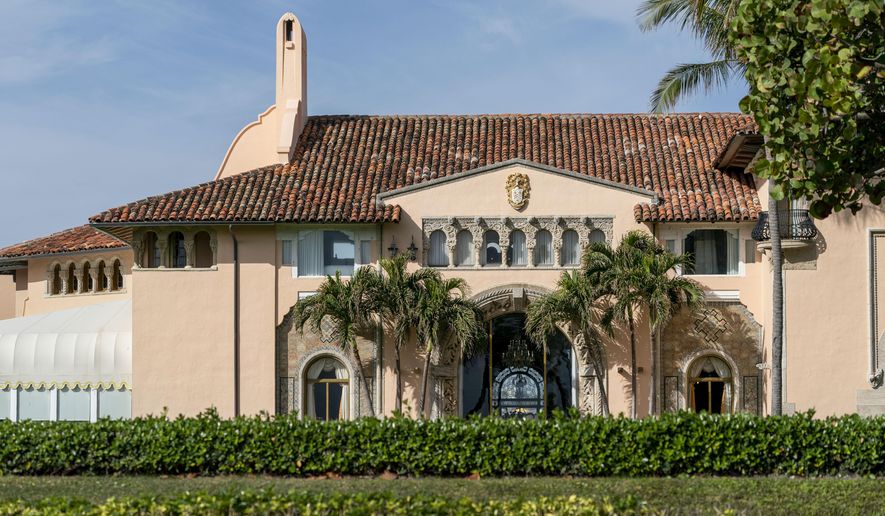FORT LAUDERDALE, Fla. (AP) - Former President Donald Trump has been living at his Mar-a-Lago club since leaving office more than a week ago - a possible violation of a 1993 agreement he made with the Town of Palm Beach that limits stays to seven consecutive days.
Town Manager Kirk Blouin said in an email Thursday that Palm Beach is examining its options and the matter might be discussed at the town council’s February meeting.
The South Florida town last month received a letter from an attorney representing a Mar-a-Lago neighbor demanding it enforce the agreement’s residency clause - something it rarely if ever did when Trump was president or before. The unnamed neighbor believes Trump’s residency would decrease property values, according to Reginald Stambaugh’s letter. Stambaugh did not return a call or email Thursday asking whether he has received a response.
Trump and former first lady Melania Trump changed their residency from New York City to Mar-a-Lago in 2019. His newly founded Office of the Former President forwarded emailed questions Thursday to the Trump Organization, the family’s business entity, which did not respond. Last month, it issued a statement saying, “There is no document or agreement in place that prohibits President Trump from using Mar-A-Lago as his residence.” Trump owns two other homes near Mar-a-Lago.
Author Laurence Leamer, a Palm Beach resident who wrote the 2019 book, “Mar-a-Lago: Inside the Gates of Power at Donald Trump’s Presidential Palace,” said this week he does not expect the town to challenge Trump if he decides to live there. He said Trump likes mingling with the club’s members and guests and have them “stroke his ego,” something he would not get living elsewhere.
“He goes through his days and people tell him he’s fantastic, he’s great, he’s unbelievable - that’s what he wants,” Leamer said.
Trump purchased Mar-a-Lago for $10 million in 1985 from the estate of Marjorie Merriweather Post, the owner of General Foods. The 126-room mansion had deteriorated after her death in 1973, when she left it to the U.S. government as a possible presidential vacation home. The government gave it back in 1981.
After Trump bought it, he spent millions upgrading the property while living there part-time.
“He must be given credit for not messing up Mar-a-Lago. Marjorie Merriweather Post built it in the ’20s and it is just one of the greatest mansions in the country,” Leamer said.
By the early 1990s, however, Trump was in financial distress. Real estate prices dropped and several of his businesses flopped, including a New Jersey casino. He told the town he could no longer afford the $3 million annual upkeep and it was unfair that he shouldered the costs alone. He proposed subdividing the property and building mansions. The town rejected the proposal.
In 1993, Trump and the town agreed he could turn the estate into a private club. It would be limited to 500 members - the initiation fee is now $200,000 and annual dues are $14,000. For an additional charge, members can stay in a suite for up to seven consecutive days and 21 days a year, the agreement says.
According to 1993 Palm Beach Post articles, Trump attorney Paul Rampell told the town council that if the agreement were approved, Trump would be treated like any other member.
“Another question that’s often asked to me is whether Mr. Trump will continue to live at Mar-a-Lago,” Rampell told the council, according to the Post. “No, except that he will be a member of the club and therefore will be entitled to the use of guest rooms.”
The length of Trump’s stays at Mar-a-Lago before his presidency are unknown, but Leamer said they often exceeded seven consecutive days and 21 days a year. During his presidency, Trump spent more than 21 days a year there, including visits of about two weeks during the Christmas holidays.
Before he became president, Trump clashed frequently with the town and its mostly staid residents over the club’s operation. Neighbors complained about noise, traffic and a car lot-sized U.S. flag and its 80-foot (24-meter) pole Trump erected in 2006 without the proper permits. The two sides eventually settled: Trump got a shorter pole and his foundation gave $100,000 to veteran charities. Trump then put the pole on a mound so it would still rise to 80 feet (24 meters).
“People say he doesn’t have the legal right to have legal residence (at Mar-a-Lago) - has the legal right ever been an issue for him?” Leamer said.
Despite the public squabbles, Trump performed well in November’s election among his neighbors - in Mar-a-Lago’s precinct, he got 62% of the vote.




Please read our comment policy before commenting.